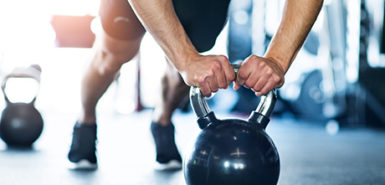
Americans have long been told that heart health depends on activities like walking, running and cycling.
But as experts continue to sift through piles of research about the relative heart health benefits of cardio versus strength training or flexibility, the conclusion about any so-called best exercise is rather surprising.
Essentially, it’s up to you.
“It all comes down to discovering your own internal motivation,” said Hannah Wright, certified exercise physiologist with the Spectrum Health Preventive Cardiology program.
“People don’t like being told what to do,” Wright said. “But when they start to see exercise in the context of their long-term health goals—whether they want to get off medication, chase after their kids and grandkids, or just feel better—they can start to see exercise as something that is in their self-interest, not just something they’re supposed to do.”
It’s not about doling out treadmill prescriptions or mandating weightlifting sessions. It’s about building solutions that suit lifestyles.
“We ask them what kind of life they envision for themselves,” Wright said.
And this hinges on a simple question: What do you want to do most?
The answer to that, when based on true inner wisdom, will invariably recognize that real motivation is derived from the “joy of living” as opposed to the “fear of dying,” Wright said.
Exercise as medicine
To understand what exercise is best for you, it may help to get a refresher in just how powerful a medicine exercise can be to begin with.
“The amount of activity we do isn’t just good for our hearts,” said Thomas Boyden, MD, cardiologist with Spectrum Health Medical Group. “It reduces risks for many things, including cancer. The more time you put into being active each week, the more likely you are to stay healthy.”
Thirty minutes of moderate exercise each day—even a brisk walk—will lower the risk of cardiovascular disease by 45 percent and lower cancer risk by 34 percent, Dr. Boyden said.
And the more you do, the bigger the benefit.
“Even moderate amounts of regular exercise can be enough to reverse some chronic diseases and help people get off medications,” he said.
If moving more and sitting less is the general goal, you should start by sketching out what your typical exercise week might look like.
Ideally, adults should strive for least 150 to 300 minutes of moderate-intensity exercise each week, or about 75 to 150 minutes of vigorous-intensity aerobic physical activity, according to the U.S. Centers for Disease Control and Prevention.
You can also opt for an equivalent combination of the two.
Does everyone achieve this? Not by a long shot.
According to the CDC, only about 23 percent of Americans actually meet these recommended standards.
Moderate intensity means you’re still able to speak in short sentences while working out, but you shouldn’t be able to sing or speak in a normal conversational voice.
In vigorous activity, you’d likely only get a few words out without pausing for breath.
The CDC also recommends adults engage in moderately challenging strength-training muscle activities twice a week.
Research continues to show weight training isn’t just good for building muscle and improving bone health—it builds heart health, too. In fact, it could be just as helpful as cardio.
In a 2018 study of 4,000 American adults, researchers tracked cardiovascular outcomes in two groups: those who engaged in a static activity, such as weight training, versus those who pursued dynamic movements, such as walking or running.
Both exercise styles were linked to a 30 to 70 percent decrease in cardiovascular disease risk factors, but the most significant declines in risk factors were seen in the static-activity group.
Build your best
If you don’t have access to fancy equipment, fret not. You can still structure workouts to suit your needs, whether you’re looking to become more active, create a structured exercise routine—or both.
“You don’t need to go to a gym for strength training,” Wright said. “There are plenty of bodyweight exercises like wall push-ups, squats or leg raises that can be done anywhere for short bouts.”
Those seeking more of a challenge can add resistance bands.
If you’re looking to try something new at home, experiment with working in some weight exercise using household items like soup cans or water bottles, walking up and down stairs, or repeatedly rising and sitting from a chair, which builds muscle.
She suggests trying to make these moves habitual—and imagine how they’ll help achieve your goals. For example, try doing calf raises while brushing your teeth and think about how it will help you walk on the beach this summer.
Don’t underestimate the lasting value of the almighty push-up and don’t overlook the need to shape workouts according to age.
You can also experiment with combinations of cardio and strength training. YouTube has videos for all levels. (Wright likes HASFit.)
For maximum benefits, consider high-intensity interval training.
These workouts involve exercises performed at high speed for very short periods—20 seconds of planks or step-ups, for example, followed by 10 seconds of rest.
Just seven minutes of interval training can have a powerful impact. One of the best aspects of these types of workouts is the abundance of free programs and apps.
Flexibility is also essential, particularly if you’re looking for something that makes you feel better fast.
“It prevents injury and increases range of motion,” Wright said. “It’s amazing the changes people see in a short amount of time. People who are gaining flexibility are able to move more freely, which aids in everyday activity and structured routines.”
Softer forms of fitness, such as yoga, are also beneficial.
“Yoga is a lot more challenging than many people give it credit for,” Dr. Boyden said. “It raises your heart rate, uses big muscle groups and lowers stress. That reduces inflammation. And it improves mental health.”
Finally, while a mix of cardio, strength training and flexibility workouts is ideal, there is one exercise that stands out above all others.
And only you will know what it is.
“The best exercise is the one you’re most likely to stick with,” Dr. Boyden said.
 /a>
/a>
 /a>
/a>
 /a>
/a>
I did enjoy the article so thanks to Sarah for interviewing, writing and editing the interviews. Lots of personal decisions regarding health-exercise and glad we have the likes of Hannah Wright in the Spectrum system!